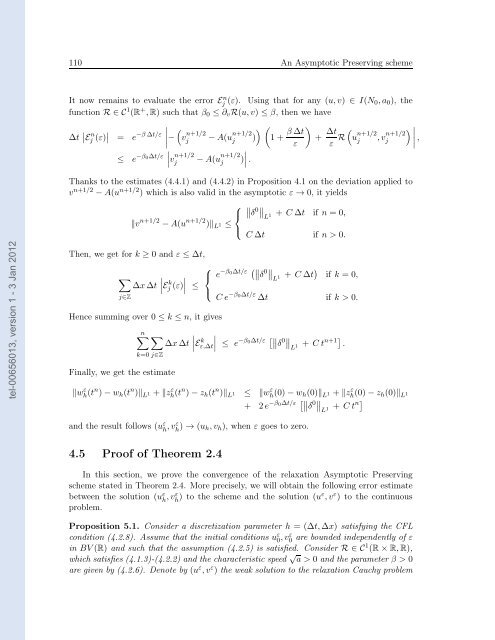Modélisation, analyse mathématique et simulations numériques de ...
Modélisation, analyse mathématique et simulations numériques de ...
Modélisation, analyse mathématique et simulations numériques de ...
You also want an ePaper? Increase the reach of your titles
YUMPU automatically turns print PDFs into web optimized ePapers that Google loves.
tel-00656013, version 1 - 3 Jan 2012<br />
110 An Asymptotic Preserving scheme<br />
It now remains to evaluate the error En j (ε). Using that for any (u,v) ∈ I(N0,a0), the<br />
function R ∈ C1 (R + ,R) such that β0 ≤ ∂vR(u,v) ≤ β, then we have<br />
∆t n<br />
Ej (ε) <br />
<br />
−β∆t/ε<br />
= e <br />
− <br />
v n+1/2<br />
j −A(u n+1/2<br />
<br />
j )<br />
<br />
1+ β∆t<br />
<br />
ε<br />
≤ e −β0∆t/ε<br />
<br />
<br />
v n+1/2<br />
j −A(u n+1/2<br />
<br />
<br />
j ) .<br />
+ ∆t<br />
ε R<br />
<br />
u n+1/2<br />
j ,v n+1/2<br />
<br />
j<br />
<br />
,<br />
Thanks to the estimates (4.4.1) and (4.4.2) in Proposition 4.1 on the <strong>de</strong>viation applied to<br />
v n+1/2 −A(u n+1/2 ) which is also valid in the asymptotic ε → 0, it yields<br />
v n+1/2 −A(u n+1/2 ⎧ <br />
⎨ 0<br />
δ<br />
)L1 ≤<br />
⎩<br />
<br />
L1 + C∆t if n = 0,<br />
C∆t if n > 0.<br />
Then, we g<strong>et</strong> for k ≥ 0 and ε ≤ ∆t,<br />
<br />
<br />
∆x∆t E k j (ε)<br />
<br />
<br />
≤<br />
j∈Z<br />
⎧<br />
⎨<br />
⎩<br />
Hence summing over 0 ≤ k ≤ n, it gives<br />
n <br />
<br />
∆x∆t<br />
k=0 j∈Z<br />
Finally, we g<strong>et</strong> the estimate<br />
E k ε,∆t<br />
e −β0∆t/ε δ 0 L 1 + C∆t <br />
if k = 0,<br />
Ce −β0∆t/ε ∆t if k > 0.<br />
<br />
<br />
≤ e −β0∆t/ε 0<br />
δ <br />
L1 + Ct n+1 .<br />
w ε h (tn )−wh(t n ) L 1 +z ε h (tn )−zh(t n ) L 1 ≤ w ε h (0)−wh(0) L 1 +z ε h (0)−zh(0) L 1<br />
+ 2e −β0∆t/ε δ 0 L 1 + Ct n<br />
and the result follows (u ε h ,vε h ) → (uh,vh), when ε goes to zero.<br />
4.5 Proof of Theorem 2.4<br />
In this section, we prove the convergence of the relaxation Asymptotic Preserving<br />
scheme stated in Theorem 2.4. More precisely, we will obtain the following error estimate<br />
b<strong>et</strong>ween the solution (u ε h ,vε h ) to the scheme and the solution (uε ,v ε ) to the continuous<br />
problem.<br />
Proposition 5.1. Consi<strong>de</strong>r a discr<strong>et</strong>ization param<strong>et</strong>er h = (∆t,∆x) satisfying the CFL<br />
are boun<strong>de</strong>d in<strong>de</strong>pen<strong>de</strong>ntly of ε<br />
condition (4.2.8). Assume that the initial conditions uε 0 ,vε 0<br />
in BV(R) and such that the assumption (4.2.5) is satisfied. Consi<strong>de</strong>r R ∈ C1 (R×R,R),<br />
which satisfies (4.1.3)-(4.2.2) and the characteristic speed √ a > 0 and the param<strong>et</strong>er β > 0<br />
are given by (4.2.6). Denote by (uε ,vε ) the weak solution to the relaxation Cauchy problem

















